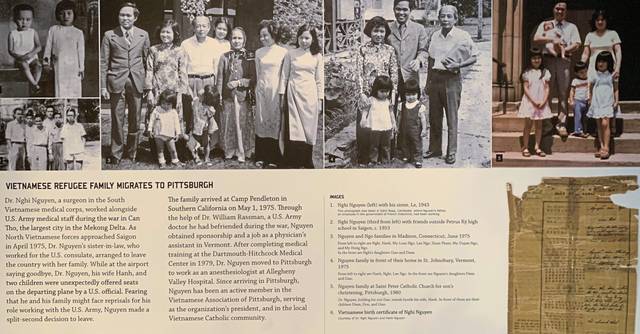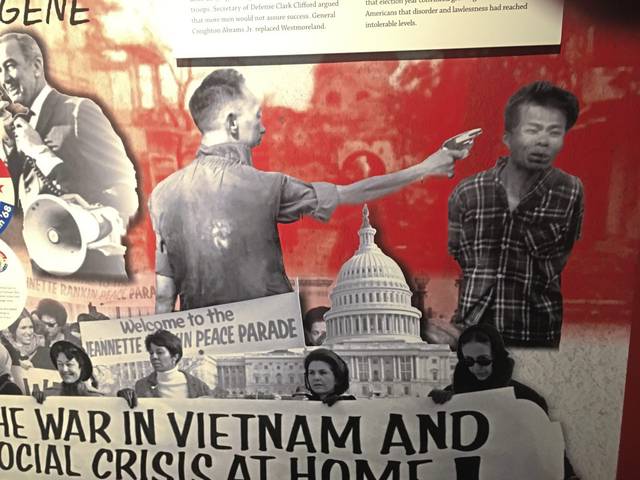Alle-Kiski residents lend voices to Vietnam War exhibit at Heinz History Center
Alle-Kiski Valley residents’ experiences and artifacts punctuate the Heinz History Center’s “The Vietnam War: 1945-1975.”
And if you want to see them, you only have until Sept. 22.
The Vietnam War exhibit has been one of the Center’s most popular exhibits attendance-wise, especially the guided tours on weekends, according to Samuel W. Black, director of the African American Program at the Heinz History Center and lead curator for the exhibit.
“The local veterans community really turned out for the exhibit, not only contributing items to exhibits, but also people have come with their families,” he said.
The exhibit created dialogue: For some people, it was the first time that they heard their grandfather or relative who was a Vietnam War veteran or involved with the war speak about their experience, according to Black.
The powerful exhibit features multi-media presentations, a medical helicopter and jeep. There’s also a replica of the Vietnam War Memorial with the names of 752 Americans killed during the war from eight counties in Western Pennsylvania.
About 45 veterans from the greater Pittsburgh area contributed in a numbers of ways to the exhibition including providing oral histories, photographs, and items such as a camera and a nurse’s uniform, Black said.
Dr. Robert Pacek, 84, of Harrison who worked as a medic is documented in the exhibit, among a number of other area residents.
Also highlighted were other aspects of the war not so well known, such as the role of women at home: Joyce Pacek of Harrison, Dr. Pacek’s wife, worked with other local women and organizations in the 1960s to send medical supplies and holiday gifts to Vietnamese children.
Dr. Pacek contributed photos to the exhibit of his work as a medic documented by the late Eddie Adams, a New Kensington native and former Daily Dispatch photographer who went on to win the Pulitzer Prize in 1968 for capturing an execution in the streets of Saigon.
That famous execution photo is featured in a collage of other war images in the exhibit.
Capt. Pacek, then a recent University of Pittsburgh graduate and medical doctor living in Tarentum, served starting in 1965 with the 142nd Army Medical Detachment near Phu Tai, Vietnam. On his days off, he would help a nearby Catholic hospital that treated North Vietnamese refugees by the thousands, mostly women and children.
“We felt so sorry for them, they were being chased, they were refugees living in tents,” said Pacek.
“We helped out a lot of kids with medicines and gifts,” he said.
Pacek said the exhibit was an opportunity to show the full Vietnam War story.
“Some people resented us being there,” he said. “We were really helping them. They’re not bad people.”
Another Alle-Kiski resident, Dr. Nghi Nguyen of Fawn , an anesthesiologist, told his story from the Vietnamese perspective. He was a surgeon in South Vietnam who left just before the country fell.
Dr. Nguyen said the exhibit is “professional” and “neutral.”
“Americans came there for a good reason,” he said. “They wanted to contain communism and help the South Vietnamese. And we appreciate the help from America and are grateful for their sacrifice.”
Dr. Nguyen points out that it is important for the public to “know the truth that the South Vietnamese fought so hard,” with about 300,000 killed, according to Nguyen, which is close to estimates used by the Vietnam embassy. About 58,000 American soldiers were killed, according to U.S. National Archives military records.
When the exhibit heads to the World War I Museum in Kansas City, the local items will be returned to residents, according to Black. However, the History Center is in the process of requesting that some of the item stay permanently for future exhibits, he said.
Remove the ads from your TribLIVE reading experience but still support the journalists who create the content with TribLIVE Ad-Free.



